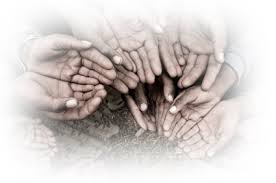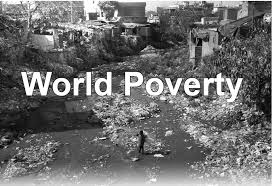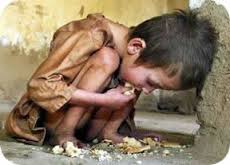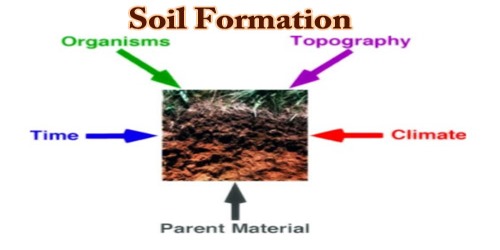Poverty is the condition of lacking basic human needs such as nutrition, clean water, health care, clothing, and shelter because of the inability to afford them.This is also referred to as absolute poverty or destitution. Relative poverty is the condition of having fewer resources or less income than others within a society or country, or compared to worldwide averages.
Poverty can be defined in many different ways. Some attempt to reduce it to numbers, while others argue that a more ambiguous definition must be used. In the end, a combination of both methods is best. Today, most economists and social workers use two ways to define poverty.
Social Definitions of Poverty:
Some people describe poverty as a lack of essential items – such as food, clothing, water, and shelter – needed for proper living. At the UN’s World Summit on Social Development, the ‘Copenhagen Declaration’ described poverty as “…a condition characterised by severe deprivation of basic human needs, including food, safe drinking water, sanitation facilities, health, shelter, education and information.” When people are unable to eat, go to school, or have any access to health care, then they can be considered to be in poverty, regardless of their income. To measure poverty in any statistical way, however, more rigid definitions must be used.
Statistical Definitions of Poverty:
While there are various numerically defined methods to measure and quantify poverty, two are simple enough that they are often used to define poverty (other methods are examined in the Measuring Poverty I and Measuring Poverty II sections of this site), relative poverty measurement and absolute poverty measurement. Both are based on income or consumption values making gathering information to compile statistics on poverty much easier.
Relative Poverty:
Relative poverty measures are the simplest ways to determine the extent of poverty in individual countries. Using this method, the entire population is ranked in order of income per capita. The bottom 10% (or whatever percentage the government chooses to use) is then considered ‘poor’ or ‘impoverished.’ This can be fine for country-wide measurements, but it has some major drawbacks in global use. If, say, a 10% relative poverty measurement was applied in a global setting, it would appear that both an industrialized country, such as the U.S., and a sub-Saharan African country had the same 10% poverty rate, even though the conditions of the poor in sub-Saharan Africa are much worse than conditions in the U.S. For this reason, absolute poverty measures are more often used to define poverty on a global scale.
Absolute poverty:
Poverty is usually measured as either absolute or relative poverty (the latter being actually an index of income inequality). Absolute poverty refers to a set standard which is consistent over time and between countries. The World Bank defines extreme poverty as living on less than US $1 (PPP) per day, and moderate poverty as less than $2 a day. It estimates that “in 2001, 1.1 billion people had consumption levels below $1 a day and 2.7 billion lived on less than $2 a day.”
The proportion of the developing world’s population living in extreme economic poverty fell from 28 percent in 1990 to 21 percent in 2001. Most of this improvement has occurred in East and South Asia. In East Asia the World Bank reported that “The poverty headcount rate at the $2-a-day level is estimated to have fallen to about 27 percent [in 2007], down from 29.5 percent in 2006 and 69 percent in 1990.” In Sub-Saharan Africa extreme poverty went up from 41 percent in 1981 to 46 percent in 2001, which combined with growing population increased the number of people living in poverty from 231 million to 318 million. In the early 1990s some of the transition economies of Eastern Europe and Central Asia experienced a sharp drop in income. The collapse of the Soviet Union resulted in large declines in GDP per capita, of about 30 to 35% between 1990 and the trough year of 1998 (when it was at its minimum). As a result poverty rates also increased although in subsequent years as per capita incomes recovered the poverty rate dropped from 31.4% of the population to 19.6%
World Bank data shows that the percentage of the population living in households with consumption or income per person below the poverty line has decreased in each region of the world since 1990:
Region | 1990 | 2002 | 2004 |
| East Asia and Pacific | 15.40% | 12.33% | 9.07% |
| Europe and Central Asia | 3.60% | 1.28% | 0.95% |
| Latin America and the Caribbean | 9.62% | 9.08% | 8.64% |
| Middle East and North Africa | 2.08% | 1.69% | 1.47% |
| South Asia | 35.04% | 33.44% | 30.84% |
| Sub-Saharan Africa | 46.07% | 42.63% | 41.09% |
Other human development indicators have also been improving. Life expectancy has greatly increased in the developing world since WWII and is starting to close the gap to the developed world. Child mortality has decreased in every developing region of the world. The proportion of the world’s population living in countries where per-capita food supplies are less than 2,200 calories (9,200 kilojoules) per day decreased from 56% in the mid-1960s to below 10% by the 1990s. Similar trends can be observed for literacy, access to clean water and electricity and basic consumer items.
There are various criticisms of these measurements. Shaohua Chen and Martin Ravallion note that although “a clear trend decline in the percentage of people who are absolutely poor is evident … with uneven progress across regions…the developing world outside China and India has seen little or no sustained progress in reducing the number of poor”.
Since the world’s population is increasing, a constant number living in poverty would be associated with a diminshing proportion. Looking at the percentage living on less than $1/day, and if excluding China and India, then this percentage has decreased from 31.35% to 20.70% between 1981 and 2004.
The 2007 World Bank report “Global Economic Prospects” predicts that in 2030 the number living on less than the equivalent of $1 a day will fall by half, to about 550 million. An average resident of what we used to call the Third World will live about as well as do residents of the Czech or Slovak republics today. Much of Africa will have difficulty keeping pace with the rest of the developing world and even if conditions there improve in absolute terms, the report warns, Africa in 2030 will be home to a larger proportion of the world’s poorest people than it is today.
The reason for the faster economic growth in East Asia and South Asia is a result of their relative backwardness, in a phenomenon called the convergence hypothesis or the conditional convergence hypothesis. Because these economies began modernizing later than richer nations, they could benefit from simply adapting technological advances which enable higher levels of productivity that had been invented over centuries in richer nations.
Income vs. Consumption:
Before absolute poverty measures can be used to define poverty, researchers must first determine if they want to measure income amounts or consumption amounts. Income refers to the amount of money someone makes, while consumption refers to the monetary value of the goods that person actually consumes. If you earn $4 a day, but are able, through other means, to consume $5 a day, then your yearly income would be $1,440, but your yearly consumption would only be $1,860. The differences can be significant, because depending on their situation poor people may be able to get goods for less. While it might appear at first glance that income and consumption are the same, closer examination reveals that income is just one factor, albeit a large one, which determines consumption amounts.
Empowerment:
“Poverty should be defined by an individual’s inability to affect change in their lives…”
– ‘Save the Children
One other factor many experts on poverty talk about when they talk about defining poverty is empowerment. ‘Empowerment’ refers to the ability of an individual to make choices regarding his or her life. Often, the poor are not empowered – they are forced to work at certain jobs or do certain things, and often, this state of existence can be linked to poverty. When people are disempowered, many times, they are in poverty.
Consistent Poverty:
This measure identifies the proportion of people, from those with an income below a certain threshold (less than 60% of median income), who are deprived of two or more goods or services considered essential for a basic standard of living.
At risk of poverty:
The ‘at risk of poverty’ indicator identifies all those (households or people) who fall below a certain income threshold, which in the EU has been set at 60% of the median income. Median income is the amount that divides the income distribution into two equal parts, half of people having incomes above the median and half having incomes below the median. This measure is the best known and quoted indicator as it affords some comparisons with other countries. It does not, however, measure poverty as such, but rather the proportion of people below a certain income threshold who may be ‘at risk of poverty’. Whether persons below the 60 per cent threshold are actually experiencing poverty will depend on a number of factors. These include:
- The degree to which income is below the relevant thresholds;
- The length of time on this relatively low income – a long such period can lead to real deprivation, as a person’s assets run down and cannot be fully maintained or replaced;
- Possession and use of other assets, especially one’s own home.
The problems inherent in using the ‘at risk of poverty’ indicator for international comparisons were restated in an article in the UN Development Programme journal “Development and Transition”, which concluded that:
- The results too often belie common sense;
- The ‘at risk of poverty’ label sends the wrong signal to the public and policy makers;
- The ‘risk of poverty’ logic does not lead to effective national policy.
What the are terms used:
Many words concerning poverty and social exclusion are used interchangeably. However, they do have different meanings, as defined below:
- Deprivation is defined as unmet basic human needs;
- Poverty is deprivation due to a lack of resources, both material and non-material, e.g. income, housing, health, education, knowledge and culture. It requires a threshold to measure it;
- Social exclusion is being unable to participate in society because of a lack of resources that are normally available to the general population. It can refer to both individuals, and communities in a broader framework, with linked problems such as low incomes, poor housing, high crime environments and family problems;
- Inequality is a comparative or relative concept. It does not measure deprivation or poverty and does not require a threshold. It is possible for inequality to exist with or without poverty. Similarly, poverty can exist with or without inequality;
- Resources can be personal, within the family, or within the society.
How we can measure poverty:
There is no one measure that gives a complete picture of the situation regarding deprivation, poverty and social exclusion. This is particularly true for a country like Ireland that has experienced rapid economic growth over the last ten years. Therefore, a number of indicators are used to measure progress in achieving social inclusion covering areas such as income, levels of deprivation, early school leaving, jobless households, long-term unemployment, and life expectancy.
Indicators such as these are also used at EU level to obtain a picture of the situation regarding poverty and social exclusion across Member States. In June 2006 EU Member States adopted a revised set of common indicators of social protection and social inclusion. The main social inclusion indicators are as follows:
Income:
- At risk of poverty rate
- At risk of poverty rate anchored at a fixed moment in time
- Persistent at risk of poverty rate
- At risk of poverty gap
- At risk of poverty rate before social transfers
- Dispersion around the at risk of poverty threshold
- In-work poverty risk
- S80/S20 income ratio
- Gini co-efficient
Employment:
- Long-term unemployment rate
- Regional Cohesion (dispersions of regional employment rates)
- Jobless Households
- Employment gap of immigrants
- Making work pay indicators (unemployment trap, inactivity trap, low-wage trap)
Education:
- Early school leavers
- Persons with low educational attainment
- Low reading literacy performance of pupils
Health:
- Healthy life expectancy
- Child well-being (to be developed)
Housing:
- Housing (to be developed)
Deprivation
- Material deprivation (to be developed)
- Self reported limitations in daily activities
Causes of poverty:
Causes of poverty mainly concern reasons behind the low wealth and productivity of the poor or, conversely, the shortage and inflation of the goods they consume.
Obstacles to productivity:
The unwillingness of governments and feudal elites to give full-fledged property rights of land to their tenants is cited as the chief obstacle to development. This lack of economic freedom inhibits entrepreneurship among the poor. New enterprises and foreign investment can be driven away by the results of inefficient institutions, notably corruption, weak rule of law and excessive bureaucratic burdens.It takes two days, two bureaucratic procedures, and $280 to open a business in Canada while an entrepreneur in Bolivia must pay $2,696 in fees, wait 82 business days, and go through 20 procedures to do the same. Such costly barriers favor big firms at the expense of small enterprises, where most jobs are created.[3] In India before economic reforms, businesses had to bribe government officials even for routine activities, which was a tax on business in effect. War, political instability and crime, including violent gangs and drug cartels, also discourage investment. Civil wars and conflicts in Africa cost continent some $300 billion between 1990 and 2005. Eritrea and Ethiopia spent hundreds of millions of dollars on the war that resulted in minor border changes. Lack of opportunities can further be caused by the failure of governments to provide essential infrastructure. Opportunities in richer countries drives talent away, leading to brain drains. Brain drain has cost the African continent over $4 billion in the employment of 150,000 expatriate professionals annually. Indian students going abroad for their higher studies costs India a foreign exchange outflow of $10 billion annually. High levels of corruption undermine efforts to make a sustainable impact on poverty. In Nigeria, for example, an estimated $400 billion of the country’s oil revenue has been stolen by Nigeria’s leaders between 1960 and 1999.
Poor health and lack of affordable education severely affects productivity. Inadequate nutrition in childhood undermines the ability of individuals to develop their full capabilities. Lack of essential minerals such as iodine and iron can impair brain development. 2 billion people (one-third of the total global population) are affected by iodine deficiency. In developing countries, it is estimated that 40% of children aged 4 and younger suffer from anemia because of insufficient iron in their diets. See also Health and intelligence. Similarly substance abuse, including for example alcoholism and drug abuse can consign people to vicious poverty cycles. Infectious diseases such as Malaria and tuberculosis can perpetuate poverty by diverting health and economic resources from investment and productivity; malaria decreases GDP growth by up to 1.3% in some developing nations and AIDS decreases African growth by 0.3-1.5% annually.
As a result of the business cycle, poverty rates can increase in recessions and decline in booms. During the Great Depression, in 1933, 25% of all workers and 37% of all nonfarm workers in the United States were unemployed. In New York, one child in every five was hungry.
In The Protestant Ethic and the Spirit of Capitalism, Max Weber first suggested that cultural values could affect economic success, arguing that the Protestant Reformation led to values that drove people toward worldly achievements, a hard work ethic, and saving to accumulate wealth. Others expanded on Weber’s ideas, producing modernization theory and putting forward a process that all nations should follow to become advanced industrial nations.However, researchers have gathered evidence that suggest that values are not as deeply ingrained and that changing economic opportunities explain most of the movement into and out of poverty, as opposed to shifts in values. Cultural factors, such as discrimination of various kinds, can negatively affect productivity such as age discrimination, stereotyping, gender discrimination, racial discrimination, and caste discrimination.
Shortage of basic needs:
Rises in the costs of living make poor people poorer. Poor people spend a greater portion of their budgets on food than richer people. As a result poor households, and those near the poverty threshold can be particularly vulnerable to increases in Shocks to food prices. For example in late 2007 increases in the price of grains led to food riots in some countries. The World Bank warned that 100 million people were at risk of sinking deeper into poverty. Threats to the supply of food may also be caused by Drought and the water crisis. Intensive farming often leads to a vicious cycle of exhaustion of soil fertility and decline of agricultural yields. Approximately 40% of the world’s agricultural land is seriously degraded. In Africa, if current trends of soil degradation continue, the continent might be able to feed just 25% of its population by 2025, according to UNU’s Ghana-based Institute for Natural Resources in Africa.
Health care can be widely unavailable to the poor. The loss of health care workers emigrating from impovrished countries has a damaging effect. For example, an estimated 100,000 Philippine nurses emigrated between 1994 and 2006. There are more Ethiopian doctors in Chicago than there are in Ethiopia.
Overpopulation and lack of access to birth control methods. Note that population growth slows or even become negative as poverty is reduced due to the demographic transition.
Effects of poverty:
The effects of poverty may also be causes, as listed above, thus creating a “poverty cycle” operating across multiple levels, individual, local, national and global.
Health:
One third of deaths – some 18 million people a year or 50,000 per day – are due to poverty-related causes: in total 270 million people, most of them women and children, have died as a result of poverty since 1990. Those living in poverty suffer disproportionately from hunger or even starvation and diseaseThose living in poverty suffer lower life expectancy. According to the World Health Organization, hunger and malnutrition are the single gravest threats to the world’s public health and malnutrition is by far the biggest contributor to child mortality, present in half of all cases. Every year nearly 11 million children living in poverty die before their fifth birthday. 1.02 billion people go to bed hungry every night. Poverty increases the risk of homelessness.There are over 100 million street children worldwide. Increased risk of drug abuse may also be associated with poverty. According to the Global Hunger Index, South Asia has the highest child malnutrition rate of world’s regions.Nearly half of all Indian children are undernourished, one of the highest rates in the world and nearly double the rate of Sub-Saharan Africa.
Education:
Research has found that there is a high risk of educational underachievement for children who are from low-income housing circumstances. This often is a process that begins in primary school for some less fortunate children. In the US educational system, these children are at a higher risk than other children for retention in their grade, special placements during the school’s hours and even not completing their high school education. There are indeed many explanations for why students tend to drop out of school. For children with low resources, the risk factors are similar to excuses such as juvenile delinquency rates, higher levels of teenage pregnancy, and the economic dependency upon their low income parent or parents.
Families and society who submit low levels of investment in the education and development of less fortunate children end up with less favorable results for the children who see a life of parental employment reduction and low wages. Higher rates of early childbearing with all the connected risks to family, health and well-being are majorly important issues to address since education from preschool to high school are both identifiably meaningful in a life.
Poverty often drastically affects children’s success in school. A child’s “home activities, preferences, mannerisms” must align with the world and in the cases that they do not these students are at a disadvantage in the school and most importantly the classroom. Therefore, it is safe to state that children who live at or below the poverty level will have far less success educationally than children who live above the poverty line. Poor children have a great deal less healthcare and this ultimately results in many absences from the academic year. Additionally, poor children are much more likely to suffer from hunger, fatigue, irritability, headaches, ear infections, flu, and colds. These illnesses could potentially restrict a child or student’s focus and concentration.
Violence:
Areas strongly affected by poverty tend to be more violent. In one survey, 67% of children from disadvantaged inner cities said they had witnessed a serious assault, and 33% reported witnessing a homicide. 51% of fifth graders from New Orleans (median income for a household: $27,133) have been found to be victims of violence, compared to 32% in Washington, DC (mean income for a household: $40,127).
Other aspects:
Economic aspects of poverty focus on material needs, typically including the necessities of daily living, such as food, clothing, shelter, or safe drinking water. Poverty in this sense may be understood as a condition in which a person or community is lacking in the basic needs for a minimum standard of well-being and life, particularly as a result of a persistent lack of income.
Analysis of social aspects of poverty links conditions of scarcity to aspects of the distribution of resources and power in a society and recognizes that poverty may be a function of the diminished “capability” of people to live the kinds of lives they value. The social aspects of poverty may include lack of access to information, education, health care, or political power. Poverty may also be understood as an aspect of unequal social status and inequitable social relationships, experienced as social exclusion, dependency, and diminished capacity to participate, or to develop meaningful connections with other people in society.
The World Bank’s “Voices of the Poor,” based on research with over 20,000 poor people in 23 countries, identifies a range of factors which poor people identify as part of poverty. These include:
- Precarious livelihoods
- Excluded locations
- Physical limitations
- Gender relationships
- Problems in social relationships
- Lack of security
- Abuse by those in power
- Dis-empowering institutions
- Limited capabilities
- Weak community organizations
David Moore, in his book The World Bank, argues that some analysis of poverty reflect pejorative, sometimes racial, stereotypes of impoverished people as powerless victims and passive recipients of aid programs.
Ultra-poverty, a term apparently coined by Michael Lipton, connotes being amongst poorest of the poor in low-income countries. Lipton defined ultra-poverty as receiving less than 80 percent of minimum caloric intake whilst spending more than 80% of income on food. Alternatively a 2007 report issued by International Food Policy Research Institute defined ultra-poverty as living on less than 54 cents per day. BRAC (NGO) has pioneered a program called Targeting the Ultra-Poor to redress ultra-poverty by working with individual ultra-poor women.
World-systems perspective:
World-systems perspective predicts that developing nations, referred to as periphery countries, have less long-term economic growth when they have extensive multinational corporate investment from core (developed) nations. Though there is definitely variance among periphery nations, several studies by sociologists have argued that many periphery nations that have extensive investment from the core do in fact have less long-term economic growth.[123][124][125][126][127][128][129] However, all of these studies are at least twenty years old and rely on very weak statistical methodology[citation needed]. More recent research tends to point to evidence that in general foreign direct investment benefits host countries, although the effects are not universal. Depending on some other country characteristics foreign investment may simply have no effect, whether positive or negative, on development.[130][131] World system theories imply that the best policy a country can pursue is autarky or at most trade only with other developing countries. However, large countries that embarked on this policy program, such as India and China before 1980 experienced stagnant growth and increasing poverty. These trends were only finally reversed when these countries abandoned the policy prescription of Western world systems theory academics and decided to substantially open their economies in the 1980s. A number of Latin American countries which also tried to rely on import substation and inward looking development had a similar experience.[132] There seem to be many reasons for harmful effects of core dominance. The first major reason is the problem of structural distortion. In an undistorted economy some natural resources lead to a chain of activity that creates profits, jobs, and growth. For example, consider a core nation with an extensive amount of copper deposits. Jobs are provided and profit is made first from mining the copper. Even more jobs and profits are created when the copper is refined into metal and these products are sold by retail firms, once again resulting in jobs and profits. From this whole process there is a chain of jobs and profits that provide for economic growth as well as revenue that can be used for developing things such as roads, electrical power, and educational institutions within the country. When the copper is mined in a periphery nation with ties to core nations the metal is shipped to the core where the rest of the chain is completed. The rest of the jobs and profits from the chain of activities are lost to the core nations. This is an example of structural distortion.[123] Another harmful effect is agricultural disruption. Before the modern world-system, agriculture was for local consumption, and there was little incentive for labor-saving farming methods. As a result of these traditional methods of farming and lack of a large market for their products, food was cheaper, some land was left for peasants, and jobs were more plentiful. However, with export agriculture and labor-saving methods of farming, food is more expensive, peasants are pushed off the land so more land may be used to grow products for the world market, and more machines are doing the work, resulting in less jobs. Profits are made by a small group of landowners and multinational agribusinesses, with peasants losing jobs, land, and income, which prevents them from being consumers needed for an economy to naturally develop. A third difficulty for peripheral nations are class conflicts within the nation. Economic and political elites in periphery nations often become more accommodating to corporate elites because these elites know that the corporations are investing in the country because of low labor costs, low taxes, no unions, and other things such as lax environmental policies, that are favorable to multinational corporate interests.


















